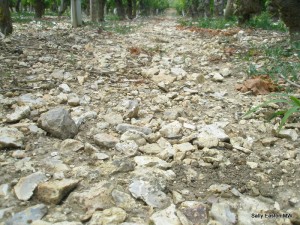Minerality quote, unquote 7
I’m still getting interesting views from producers about minerality. Here are some quotes from the Loire and New Zealand, not all in relation to sauvignon blanc!
Jo Landron, Les Domaines Landron, Muscadet, Loire Valley, June 2013
“Mineral expression is possible but it is low in vineyards cultivated traditionally [using pesticides]. You could get ten times or a hundred times more mineral expression if the soil is alive [organic / biodyniamic].”
Marie Chartier-Luneau, Domaine Luneau-Papin, Muscadet, Loire Valley, June 2013
“We recognise a trend on all the wines, the same bitterness of minerality on Pierres Blanches, Terre de Pierre and Excelsior. It is the juice of stones.” (Pierres Blanches is on gneiss, Terre de Pierre on igneous rocks and Excelsior on micaschist.)
François Robin, Interloire, June 2013
In the Coteaux de la Loire minerality is like “sucking a stone, gunflint. During a summer storm, the moment when the stones are still hot, and water releases certain smell, could be close to what is called minerality.”
Clement Pinard, Domaine Vincent Pinard, Sancerre, Loire Valley, June 2014
“Caillotte – limestone – is mineral.”
Valentina Buoso, winemaker, Pascal Jolivet, Sancerre, Loire Valley, June 2014
“Minerality is a perception in the nose and mouth of strength; a link between the fruity part and the texture part. Aroma and texture. Without this link it can’t be well married. Minerality is connected to acidity. Without acidity, we cannot have a balance.”
Jean-Laurent, Domaine Vacheron, Sancerre, Loire Valley, June 2014
“It all depends on the site, the age of the vines, the depth of the root system, the amount of clay. Enough clay makes structured wines. Less clay is more mineral, with more freshness.”
Comtesse d’Estutt d’Assay, Château de Tracy, Pouilly-Fumé, Loire Valley, June 2014
“The idea of 17,000 vines per hectare [for the Haute Densité wine, a 1ha plot of 17K vines] is to have competition between the vines to get them to send down roots to maximise minerality. We keep the yield low, 2-3 bunches per vine [<30hl/ha]. There is a lot of minerality in a few bunches.”
Sam Weaver, Churton Wines, Marlborough, New Zealand, March 2014
“I don’t associate minerality with sulfides. Minerality is associated with acid structure and pH. A low pH = stronger acid. Perception of those acids at low pH gives you minerality.”
Ruud Maasdam, Staete Landt, Marlborough, New Zealand, March 2014
“Minerality is sea salty, steely, slatey, ardoise/schist.”
Tim Finn, Neudorf Vineyards, Nelson, New Zealand, March 2014
“I don’t know where it comes from. It reminds me of sucking of stones. Almost a chlorine hit, with a refreshing end. It’s always there with acidity; it’s never there without acidity. With red, it’s with a salivatory amount of acidity.”
Blair Walter, Felton Road, Central Otago, New Zealand, March 2014
“Minerality in red wine is a less overt fruitiness, with some vineyard character; tasting the transparency of terroir.”




